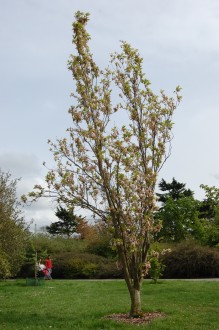Position: Full sun
Flowering period: Winter to spring
Soil: Moist, well drained
Eventual Height: 8m
Eventual Spread: 3m
Hardiness: 6a, 6b, 7a, 7b, 8a, 8b, 9a, 9b
Family: Rosaceae
Prunus serrulata ‘Amanogawa’ is a small, narrowly fastigiate, spring flowering deciduous tree. Its mid green leaves are simple, alternate, usually ovate to lanceolate with a serrate margin and up to 13cm long and 6.5cm wide. They turn orange to red in colour before falling in autumn. Its branches are upright give the tree its columnar habit. Its flowers are usually white to pink, slightly fragrant, with five petals and five sepals, are borne singly, or in umbels of two to six. Its fruit is a fleshy drupe with a singly relatively large hard coated seed.
The species Prunus serrulata is native to Japan, China and Korea. Prunus serrulata ‘Amanogawa’ is commonly known as Cherry Amanogawa, Flagpole Cherry, Japanese Flowering Cherry.
The etymological root of the binomial name Prunus is derived from the classical name of the plum. Serrulata is derived from the Latin serrula meaning ‘little saw’, in reference to the leaf margins. Amanogawa is an asteroid belt, in reference to the flowering nature of this tree.
The landscape architect may find Prunus serrulata ‘Amanogawa’ useful in compact spaces, light permitting. It also looks fantastic when planted in lines or avenues due to it columnar habit.
Ecologically, Prunus serrulata ‘Amanogawa’ is attractive to bees and pollinating insects.
The Royal Horticultural Society has given Prunus serrulata ‘Amanogawa’ their prestigious Award of Garden Merit in 1993.
Prunus serrulata ‘Amanogawa’ prefers moist, fertile, well-drained soils. It tolerates most pH of soil.
Prunus serrulata ‘Amanogawa’ requires little maintenance. Rogue (not upright) branches may be removed in summer to maintain the upright habit. Pruning should be carried out after flowering, from April to July to minimise the risk of Silver leaf infection.







Leave a comment